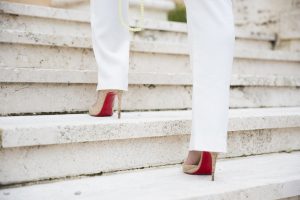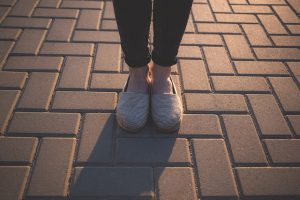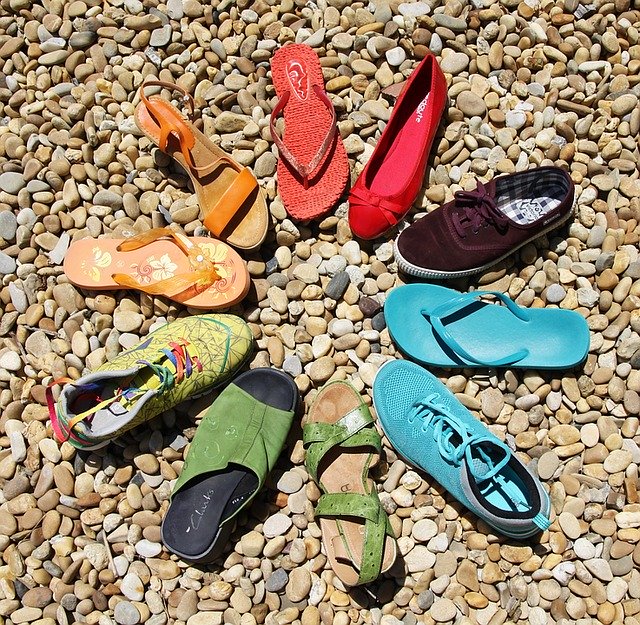High heels worn by women are the type of shoes that we typically think of when shoes are blamed for back pain. However, did you know that these are not the only kind of shoes that could be causing you to experience back pain? Flip flops or slides, flat shoes, and toning shoes are also other types that are problematic, because they don’t provide the proper support for your feet.
To understand this, you must consider your skeleton. Your spine is connected to your pelvic girdle, which is connected to your thigh and leg bones, which then connects to the bones of your ankles and feet. This description may remind you of a popular children’s song, but it essentially explains why when something goes wrong with one part of your body, it has the potential to affect other parts as well. This is referred to as the “kinetic chain” – how one part of the body moves, affects the other parts.
Therefore, if you have unexplained back pain, it may be time to consider your feet and your shoes.



Here are some things to consider about your shoes:
- You should wear the correct shoes for what you are doing. For example, if you are a runner, you need shoes with shock absorption, and you need to replace them regularly. This not only helps your feet, it provides shock absorption to the structures of your spine.
- If you must wear high heels (or you want to occasionally), keep the heel as low as possible. Research shows that the higher the heel is, the more pressure is placed on the balls of your feet, and this then negatively affects the other joints in your legs and increases the curvature of your lower back. Instead, you should choose wider heels that are more stable and less likely to throw you off balance. In addition, chose heels with a round toe box instead of the pointed toe boxes that crowd your toes, and can impact your gait.
- At the same time as you should avoid high heels as much as possible, do not wear flat shoes. Ballet flats may be cute, but these shoes do not provide support to the arches of your feet, which can not only affect your back, but also result in plantar fasciitis (a stabbing pain in your heel caused by inflammation of the fascia that runs between your toes and your heels) and heel spurs.
- Buy shoes in the afternoon, when your feet are at their largest.
- Wear shoes with sufficient toe room. This ensures that your feet move the way they should, reducing the impact on your leg joints and back.
- Replace your shoes regularly. Most exercise shoes need to be replaced every three to six months, or every 500 miles, whichever is reached first. The more you weigh, the sooner you have to replace your shoes.
- If you need more support in your current shoes, consider purchasing off-the-shelf orthotic insoles.
If, despite following the above recommendations, you still have back pain, you should consider a referral to a foot doctor such as a podiatrist, or to a pedorthist. After assessment, you may be prescribed custom orthotic insoles.
Some physical therapists and chiropractors also take extra training in the assessment and treatment of foot disorders and custom orthotics for wear inside of shoes.
No matter which specialist you see, it is helpful to take the shoes, that you regularly wear, with you to your appointment. The specialist can then check the location(s) of wear on your shoes, as this can provide a clue as to what the problem may be. The specialist will also examine your feet to determine if you perhaps have high or flattened arches, and he/she will look for other clues that are the cause of pain in your back.
To summarize, back pain can be the result of something happening lower down in your legs, including your feet and footwear. If the alignment of your lower limb joints and proper foot support can be achieved, reduction or relief of back pain is possible.

Kathy Lawrence has 20 years of experience as a Physical Therapist. Kathy received her Masters of Physical Therapy in 1999 from the University of Wisconsin – Madison. Then followed up with her Doctorate Degree in Physical Therapy in 2008 from A.T. Still University. She prides herself in her focus on Healthy Aging. Whether it’s wellness, pain management, or helping recover from an injury Kathy has been instrumental in keeping our aging population on their feet.


